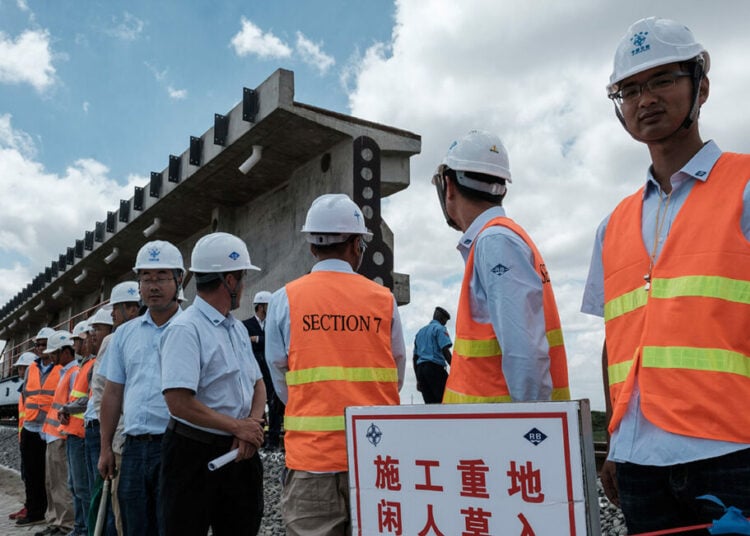China has played a central role in Nigeria’s development drive over the past two decades, emerging as a major financier of large-scale infrastructure projects.
Seen as an alternative to traditional sources of development finance such as the IMF and World Bank, China has become Nigeria’s largest bilateral lender and a key partner in the country’s quest for growth.
Chinese involvement extends well beyond trade and investment. Through loans and state-backed companies, China has supported the construction of railways, highways, and airport rehabilitations, while also supplying military equipment. These interventions have placed China at the heart of Nigeria’s development ambitions.
President Bola Tinubu has repeatedly underlined the importance of infrastructure to Nigeria’s economic transformation. But delivering on this vision depends on external financing, and China’s current economic trajectory raises questions about how much it can continue to contribute.
Data from the Debt Management Office (DMO) shows that China is Nigeria’s largest bilateral creditor with $5.5 billion in loans, representing about 12 per cent of Nigeria’s external debt. Yet analysts note that Beijing, which is also Africa’s biggest lender, has been scaling back its exposure as it confronts economic challenges at home.
The World Bank projects China’s economy to grow by 4.5 per cent in 2025, down from 5 per cent in 2024. While this is still within Beijing’s official target, trade restrictions, policy uncertainty, and structural weaknesses are slowing the momentum. Renaissance Capital’s chief economist, Charles Robertson, has warned that reduced Chinese lending could dampen growth prospects across Africa, posing additional challenges for debt markets.
Recent trade data highlights further difficulties. China’s exports have weakened, partly due to restrictions following Donald Trump’s return to the U.S. presidency with his ‘America First’ policies. Economists stressed that the slowdown is not simply the result of the pandemic or trade frictions but part of a longer-term structural shift in the Chinese economy.
For more than three decades, China sustained double-digit growth, but now the country is facing what economists call the “middle-income trap.” This occurs when emerging economies, after narrowing the gap with advanced nations by adopting technology and capital, struggle to sustain growth because they must begin innovating independently. China’s growth targets, which have gradually declined from 5.5 per cent in 2022 to 5 per cent in 2023, reflect this reality.
Typically, the middle-income trap springs at an income level equal to between 10 and 30 per cent of the income level in the world’s leading nation, the United States. It is the stage at which a developing nation either stops catching up or reduces its catch-up pace.
The bigger a country, the tougher it is to grow faster. For instance, it is easier for a $10 billion economy to expand by 10 per cent by achieving a $1 billion growth, than for a $100 billion economy to achieve 10 per cent growth by adding 10 per cent to its GDP. It happens with every economy. China cannot maintain unfettered growth ad infinitum.
Another structural challenge is demographics. For more than half a century, China’s one-child policy has reduced the working-age population, driving up wages and undermining its traditional advantage as a low-cost manufacturing hub. Rising labour costs are forcing manufacturers to shift production to countries like Bangladesh and Indonesia. At the same time, inflationary pressures are emerging from wage demands, eroding competitiveness. Similar signs of slowdown were seen earlier in Japan, Korea, and Taiwan at the height of their economic booms.
In the past decade, the size of China’s workforce has been declining. Consequently, China has been experiencing wage-driven and structural inflation. With China’s impressive growth over the past half-century, there has been a huge demand for labourers, skilled and unskilled. With time, labourers have demanded higher wages.
A sudden rise in factory wages was the most important warning sign that at the peak of their boom decades, economic growth in Korea, Japan and Taiwan was about to slow sharply. China has hit that point.
Sharply increasing wages call into serious question the future of a Chinese economy that is built on cheap labour and exports. Rising wages are compelling manufacturers to move plants to cheaper labour markets in countries like Indonesia and Bangladesh, so the export-manufacturing boom may have actually hit its limit and may start moving in the reverse.
Although doubtless still the manufacturing capital of the world, there are also limits to how far any country can expand its labour force in manufacturing.
Research from the Multidisciplinary Digital Publishing Institute (MDPI) shows that by 2020, labour-intensive enterprises made up 27 per cent of China’s total manufacturing firms, with more than half of the sector’s workforce employed in them. Sustaining this share will be increasingly difficult.
Taken together, these factors mean China is unlikely to sustain the rapid growth that made it such a formidable development partner for countries like Nigeria. For Nigeria, this raises important questions. If Beijing is constrained, Abuja may need to explore new ways to finance development.
For President Tinubu, the implication is clear: while China will remain an important partner, Nigeria cannot rely on Beijing alone. Strengthening domestic revenue, cutting the cost of governance, closing fiscal leakages, and expanding the use of public-private partnerships for infrastructure could become central to keeping the country’s ‘Renewed Hope’ development agenda on track.





